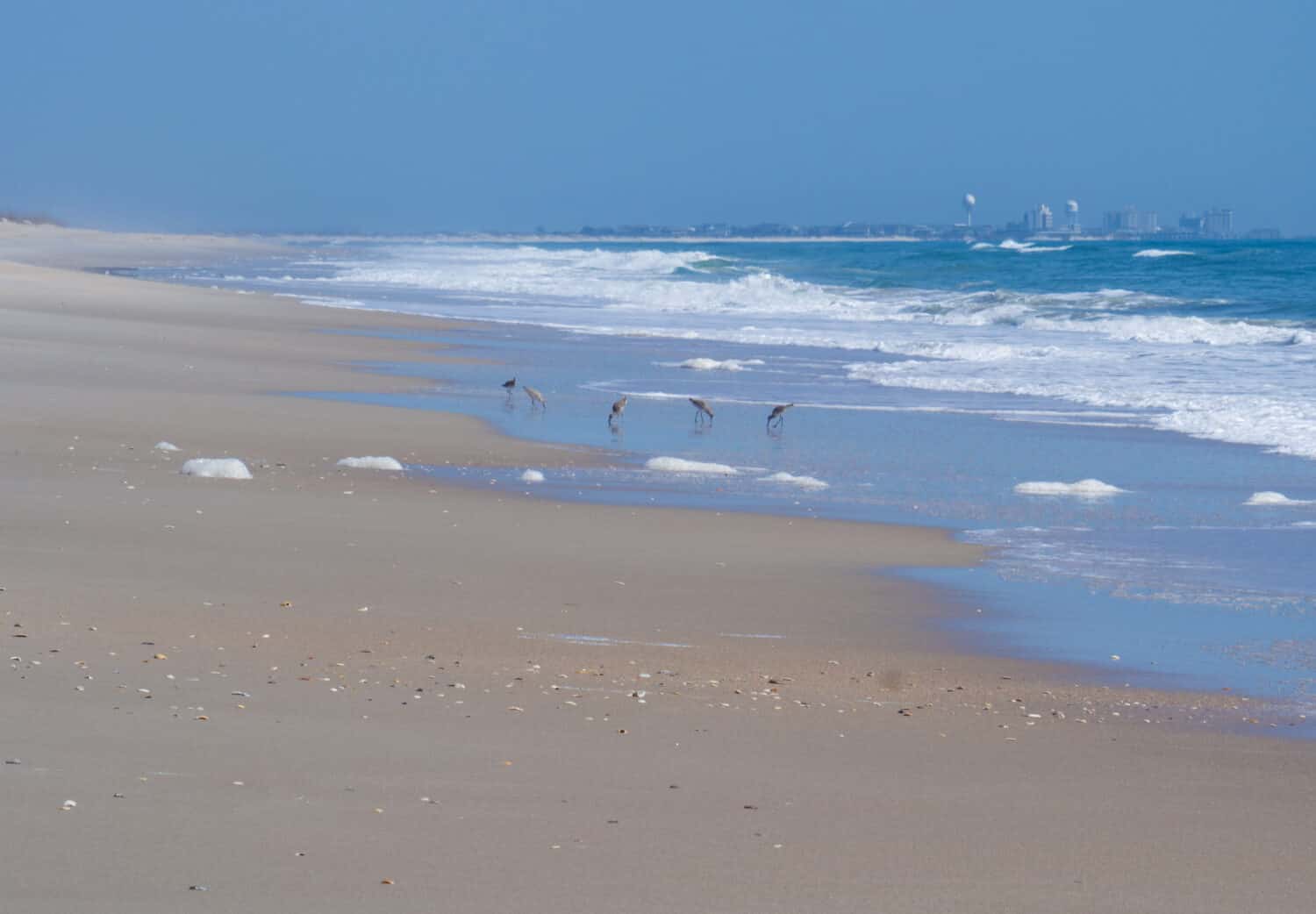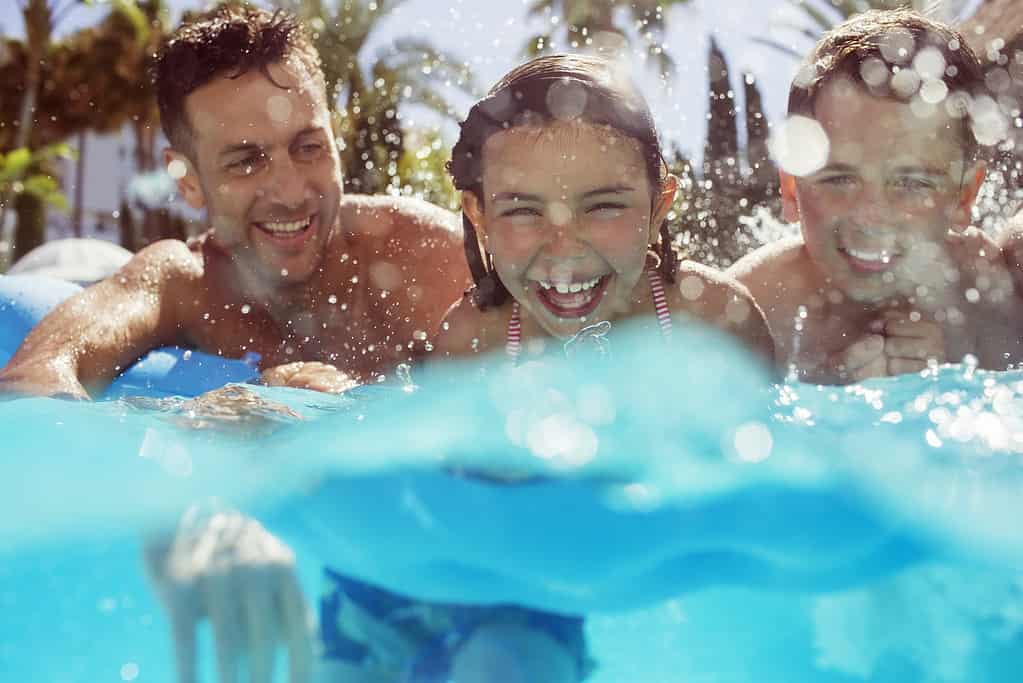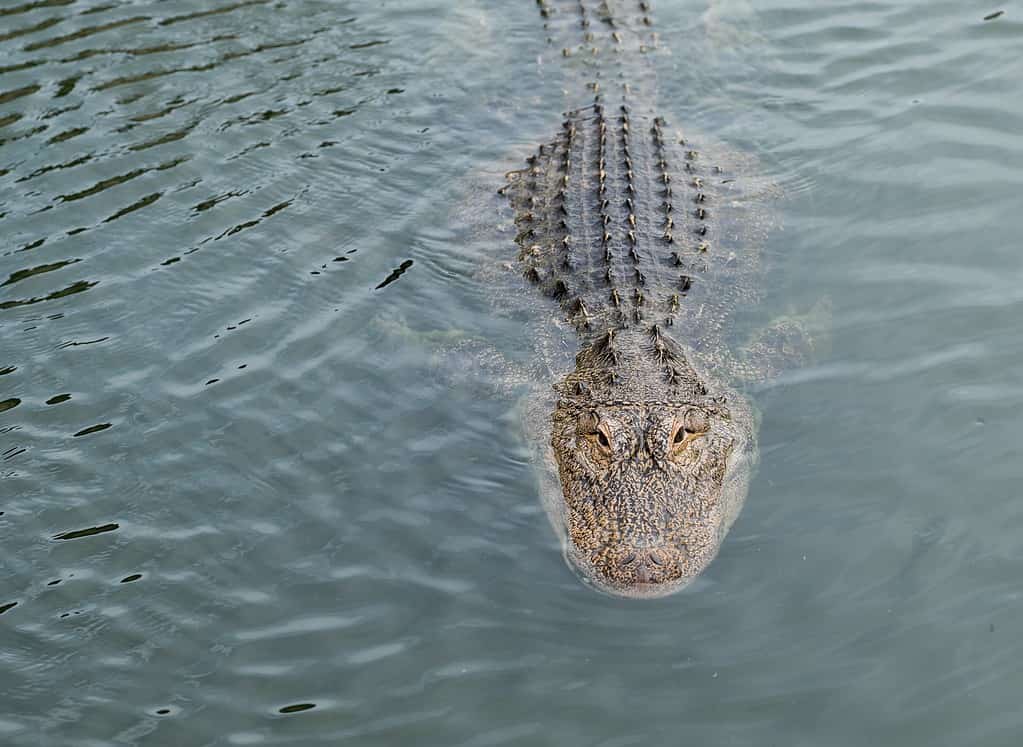The southern coastal parts of the Southeast are home to American alligators. North Carolina happens to be the northernmost part of their range. They are abundant in the eastern inland and coastal wetlands, waterways, tidal basins, and even lakes and swamps of North Carolina. They will even occasionally go into the ocean.
Does this make the waters throughout North Carolina dangerous for humans to enjoy? Can you find alligators in every body of water in the state? We’ve done the research and have brought you everything you need to know about these apex predators and where they roam in the Tar Heel State.
How Big Are Alligators in North Carolina?

Never swim in waters that have alligators.
©Yordan Balabanov/Shutterstock.com
Males gators in North Carolina can weigh up to 500 pounds and measure up to 13 feet long. Females typically weigh up to 200 pounds and reach a length of less than nine feet. On its back, where tiny bones called osteoderms form a hard ridged armor, its leathery skin is the strongest.
The alligator, however, retains more flexibility because these flat, hard bones are not joined together the way they are in other creatures. Gators have a neck that is short, stout legs, and large tails that they utilize to move through the water.
Their broad nose is beneficial for digging. Despite popular perception, these creatures do not harm their prey with their tails.
Where Are Alligators Found in North Carolina?
The American alligator, which also resides in the southeastern United States, is the sole species of alligator present in North Carolina. This species of alligator inhabits the southeast region of the state, which borders South Carolina’s outer banks.

Both North and South Carolina have alligators.
©iStock.com/albertc111
They typically live in freshwater areas in North Carolina east of Robeson County and north of Gates County. Several counties along the coast are home to the largest population of gators. These include Brunswick, New Hanover, Craven, Onslow, and Pender.
Additionally, alligators have even been discovered on beaches along the eastern coast of the state. In North Carolina, alligators are mostly found in the lower Cape Fear and Neuse River Valleys, but they also saunter across a large portion of the Coastal Plain south of the 36th parallel.
This area divides Albemarle Sound longitudinally. A few unusual creatures make it deep into Piedmont, like the gator that was released from a golf club close to Kings Mountain. Alligators have been seen in the waters of Masonboro Island in North Carolina.

Masonboro Island is a beautiful place to get away.
©Coastal Girl/Shutterstock.com
Gator encounters in the ocean are uncommon, but not unheard of. Because they can swim well, alligators can move far offshore. It’s vital to preserve your distance from any alligators you observe on the beach and not contact or bother them.
Although alligators do not normally frequent cities like Raleigh, they may move into them if construction or similar reasons forcibly remove them from their native environment.
How to Safely Swim in North Carolina Waters
There’s no denying that there is danger throughout most bodies of water in this state. Not only are there alligators to worry about, but there are also jellyfish, sharks, and other dangers. That said, residents and visitors can still safely enjoy cooling off in the water.

If you can, visit a waterpark instead!
©iStock.com/Caiaimage/Paul Bradbury
Keep your splashing to a minimum. Splashing around signals the presence of something to eat to a gator in its eyes and mind. Although you possibly may be a source of food, the alligator believes that the sources are fish, land animals swimming, or birds that land on top of the water’s surface.
Before going for a swim, it’s a good idea to take off your jewelry. Jewelry will sparkle and gleam in the sun when worn in alligator-infested waterways. Alligators will interpret this as a reflection of a fish’s scales’ sheen and assume that it is time for food.
Provide the predator a way out of the water if one comes your way. The majority of alligators are afraid of people, thus they don’t want to be close to you. This implies that if you spot one swimming, allow it enough room to go away from you and to escape.
Avoid approaching it in order to take that picture for social media because the alligator can see your approach as hostile and try to attack.
How to Tell If an Alligator Is in Water

Gators can easily stay hidden in water.
©David Louis Tiffany/Shutterstock.com
It is possible to find an alligator in a reservoir, lagoon, or river in a number of different ways.
Check the shoreline first to determine if an alligator hangs out there. Alligators enjoy lying out in the sun on the sand so that you can spot them by the sliding water re-entry markings.
Secondly, search for them in weedy, muddy regions that are hidden from possible prey. Lastly, pay attention to the gator’s hissing, which serves as a signal that you are in his domain.
The photo featured at the top of this post is © Concepcion Gonzalez/Shutterstock.com
Thank you for reading! Have some feedback for us? Contact the AZ Animals editorial team.






